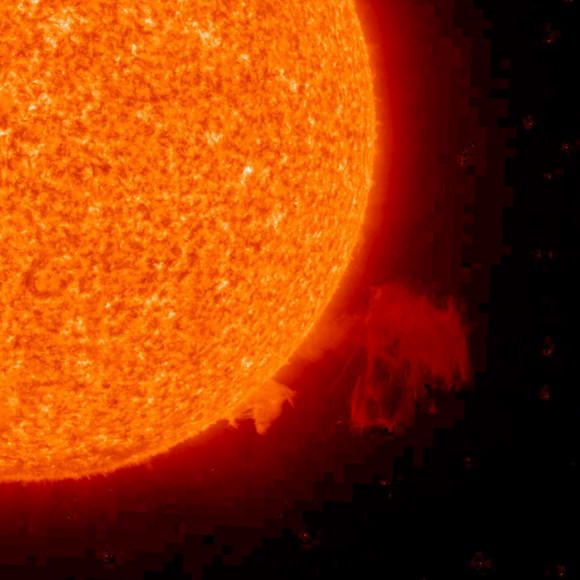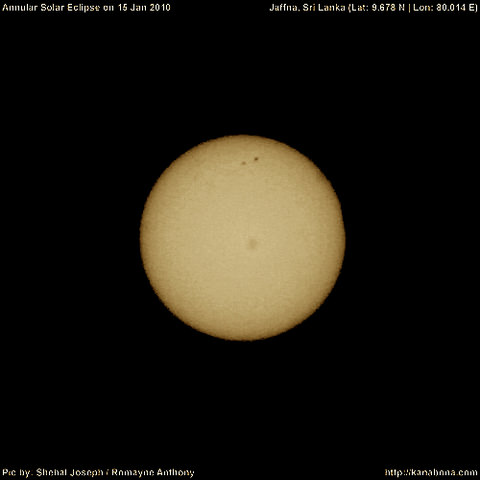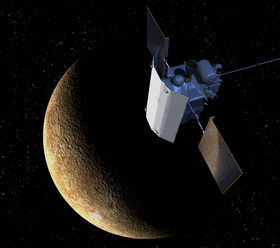Early Tuesday morning (August 9, 2011,) the Sun erupted with the largest solar flare of Cycle 24, registering as an X7-class flare. This flare had an X-ray magnitude of X6.9, meaning it was more than 3 times larger than the previous largest flare of this solar cycle – the X2.2 that occurred on Feb 15, 2011, NASA said. The source was Sunspot 1263 which is nearing the western limb of the Sun, and because of its location, scientists do not anticipate that this explosion will hit Earth directly. Therefore, the impact on communications and electric grids will likely (and luckily) be minimal.
Continue reading “Sun Erupts with Largest Solar Flare of the Cycle”
How Big Are Solar Flares?
With the recent activity on the Sun, we’ve used the words “massive” or “huge” to describe solar flares. But just how big are they, really? This great video explains and illustrates the actual size of solar flares.
Thanks to Scott Stevenson for creating and sending us the video. Scott notes that text subtitles are available if you click on the “CC” button on the bottom of the video screen, making this informative video accessible to a wider audience.
Solar Storm Heading Our Way
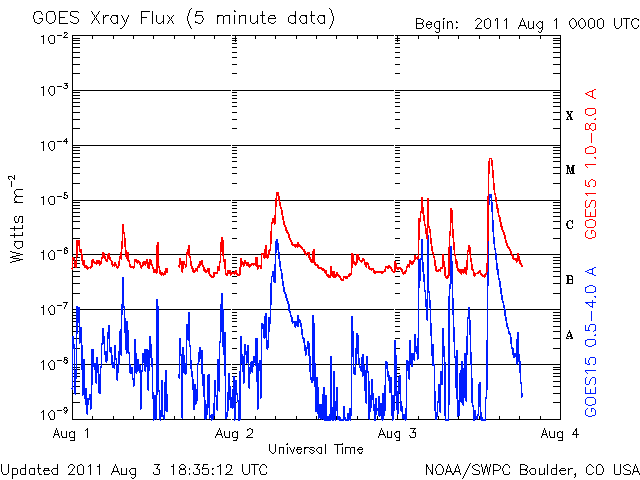
Early today, (Aug 3, 2011) two active regions on the Sun, sunspot 1261 and 1263 unleashed solar flares, which was captured by NASA’s Solar Dynamics Observatory. The above video shows an M6 class flare from 1261 in a couple of different wavelengths. SolarstormWatch, a citizen science project through the Royal Observatory in Greenwich, England predicts the solar storm from the larger flare to reach Earth at 15:00 UTC on August 5, 2011, and also predict direct hit on Earth.
See below for a graph of the activity:
[/caption]
Solar storms are a concern if they hit Earth directly since under the right conditions, they can create extra electrical currents in Earth’s magnetosphere. The electrical power grid is vulnerable to any extra currents, which can infiltrate high-voltage transmission lines, causing transformers to overheat and possibly burn out.
Check SpaceWeather.com and the National Weather Service’s Space Weather Prediction Center for more information.
Interacting Sunspots Spawn Gigantic Solar Flare
The largest solar flare recorded in nearly five years was triggered by interactions between five rotating sunspots, say researchers who studied observations of the flaring region of the Sun taken by the Solar Dynamics Observatory over a period of five days. The flare occurred at 1.44am on February 15,2011, when the Sun released the largest recorded solar flare since December 2006 and the first flare of the current solar cycle to be classified as the most powerful “X-class”.
Continue reading “Interacting Sunspots Spawn Gigantic Solar Flare”
Sun Erupts with Enormous X2 Solar Flare
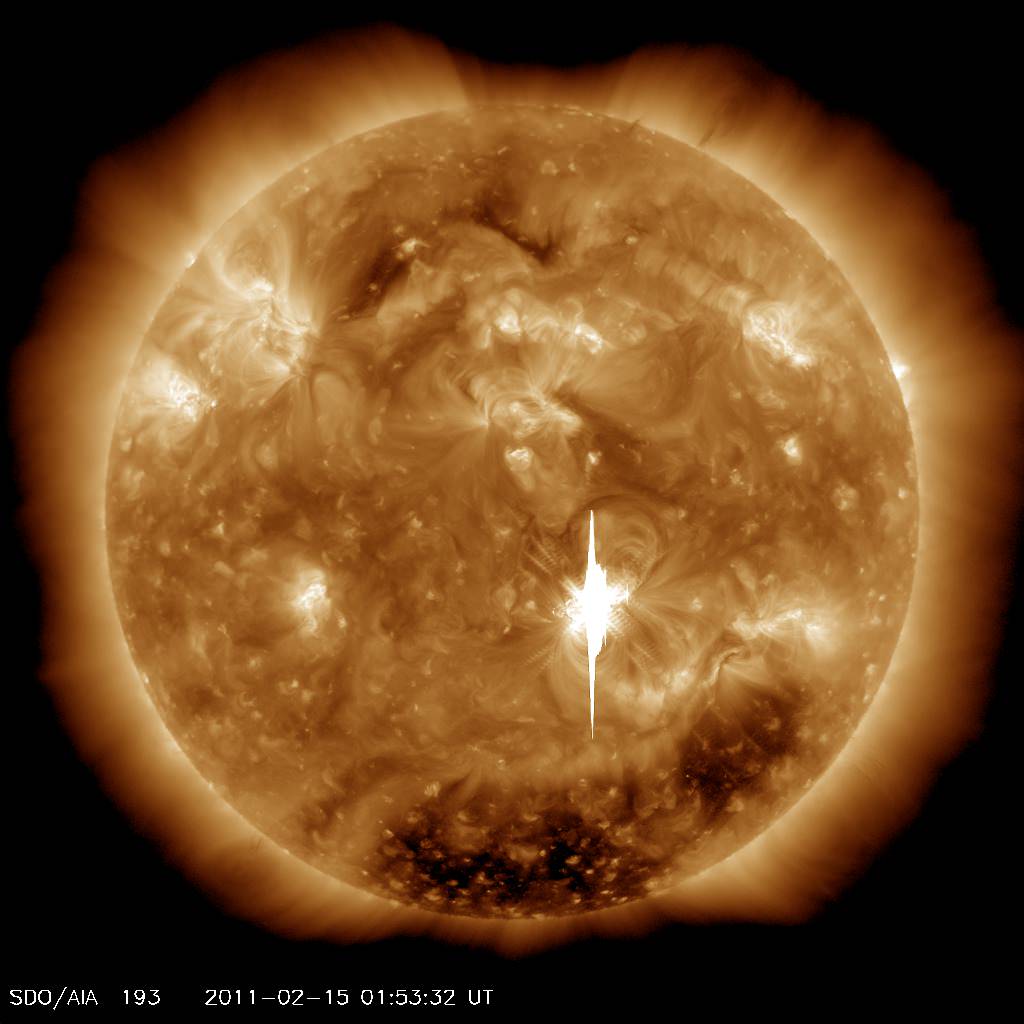
Just in time for Valentine’s Day, [and the Stardust flyby of Comet Tempel 1] the Sun erupted with a massive X-Class flare, the most powerful of all solar events on February 14 at 8:56 p.m. EST . This was the first X-Class flare in Solar Cycle 24 and the most powerful X-ray flare in more than four years.
The video above shows the flare as imaged by the AIA instrument at 304 Angstroms on NASA’s Solar Dynamics Observatory. More graphic videos below show the flare in the extreme ultraviolet wavelength of 193 Angstroms and as a composite with SOHO’s coronagraph.
Spaceweather Update: A CME hit Earth’s magnetic field at approximately 0100 UT on Feb. 18th (8:00 pm EST on Feb. 17th). Send me or comment your aurora photos
The eruption registered X2 on the Richter scale of solar flares and originated from Active Region 1138 in the sun’s southern hemisphere. The flare directly follows several M-class and C-class flares over the past few days which were less powerful. The explosion also let loose a coronal mass ejection (CME) headed for Earth’s orbit. It was speeding at about 900 Km/second.
CME’s can disrupt communications systems and the electrical power grid and cause long lasting radiation storms.
According to a new SDO update, the particle cloud from this solar storm is weaker than first expected and may produce some beautiful aurora in the high northern and southern latitudes on Feb. 17 (tonight).
According to spaceweather.com, skywatchers in the high latitudes should be alert for auroras after nightfall Feb. 17 from this moderately strong geomagnetic storm.
Send me your aurora reports and photos to post here
Sources: SDO website, spaceweather.com
NASA SDO – Big, Bright Flare February 15, 2011
Video Caption: Active region 1158 let loose with an X2.2 flare at 0153 UT or 8:50 pm ET on February 15, 2011, the largest flare since Dec. 2006 and the biggest flare so far in Solar Cycle 24. Active Region 1158 is in the southern hemisphere, which has been lagging the north in activity but now leads in big flares! The movie shows a close-up of the flaring region taken by the Solar Dynamics Observatory in the extreme ultraviolet wavelength of 193 Angstroms. Much of the vertical line in the image and the staggered lines making an “X” are caused by the bright flash overwhelming our imager. A coronal mass ejection was also associated with the flare. The movie shows activity over about two days (Feb. 13-15, 2011). Since the active region was facing Earth, there is a good chance that Earth will receive some effects from these events, with some possibility of mid-latitude aurora Feb. 16 – 18. Credit: NASA SDO
X2 flare Video combo from SDO and SOHO
Video caption: The X2 flare of Feb. 15, 2011 seen by SDO (in extreme ultraviolet light) enlarged and superimposed on SOHO’s coronagraph that shows the faint edge of a “halo” coronal mass ejection as it races away from the Sun. The video covers about 11 hours
[/caption]
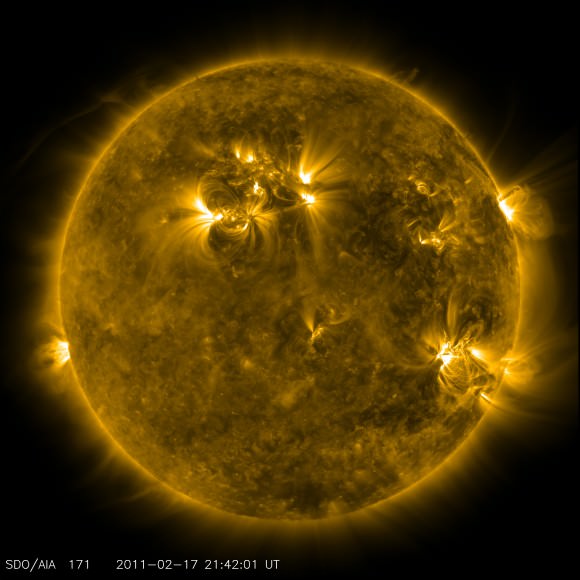
Solar Flares Can Now Be Predicted More Accurately
[/caption]
We all like to know in advance what the weather is going to be like, and space weather is no different. However, predicting solar storms from the sun — which can disrupt satellites and even ground-based technologies — has been difficult. But now scientists say magnetic loops breaking inside the sun provide two to three-day warnings of solar flares. “For the first time, we can tell two to three days in advance when and where a solar flare will occur and how large it will be,” said Alysha Reinard, from the NOAA Space Weather Prediction Center.
Reinard and her team found that sound waves recorded from more than 1,000 sunspot regions reveal disruptions in the sun’s interior magnetic loops that predict a solar flare. They found the same pattern in region after region: magnetic twisting that tightened to the breaking point, burst into a large flare, and vanished. They established that the pattern could be used as a reliable tool for predicting a solar flare.
“These recurring motions of the magnetic field, playing out unseen beneath the solar surface, are the clue we’ve needed to know that a large flare is coming—and when,” said Reinard.
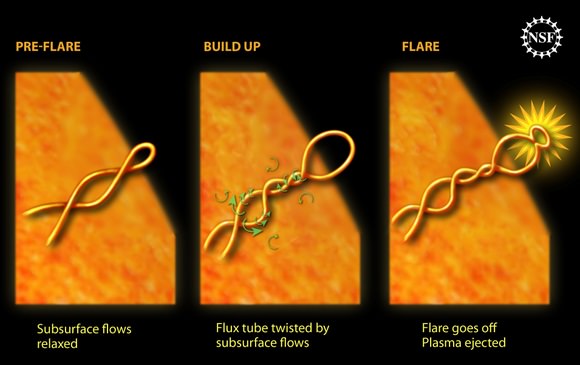
The new technique is already twice as accurate as current methods, according to the authors, and that number is expected to improve as they refine their work over the next few years. With this technique, reliable watches and warnings should be possible before the next solar sunspot maximum, predicted to occur in 2013.
“Two or three days lead time can make the difference between safeguarding the advanced technologies we depend on every day for our livelihood and security, and the catastrophic loss of these capabilities and trillions of dollars in disrupted commerce,” said Thomas Bogdan, director of NOAA’s Space Weather Prediction Center.
The team’s paper has been accepted for publication by the Astrophysical Journal Letters.
Source: NOAA
Eclipse Sunspots Signal Increased Activity
[/caption]
Astrophotographers capturing the recent annular solar eclipse on January 15, 2010 got an added bonus: upon closer inspection, they found sunspot 1040 also showed up on their images, too. “We didn’t mean to catch sunspots in our Jaffna Eclipse expedition, nor did we plan to,” said Prasanna Deshapriya, one of the members of the Eclipse Hunt 2010 crew, featured in our eclipse photo and video collection. “But surprisingly this is what really happened.”
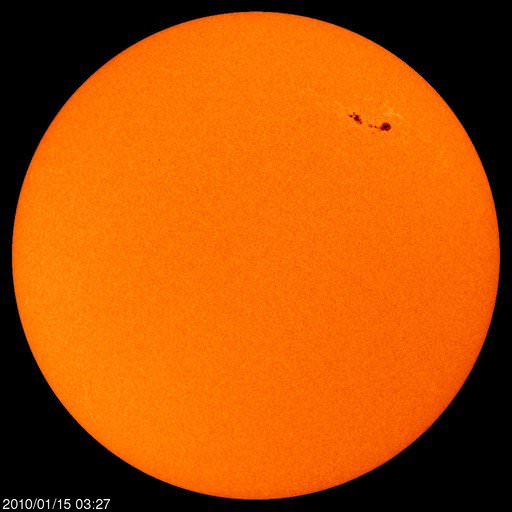
The rather big sunspot 1040, which was also captured by the SOHO spacecraft on Jan. 15 has just disappeared over the sun’s western limb, currently leaving the visible disk of the sun blank once again in this uncharacteristically long solar minimum. But our old friend, sunspot 1039 should be showing up soon, as the sun rotates around. We know it is still there, because the STEREO spacecraft can show us what is going on the sun’s far side. Sunspot 1039 should emerge for direct viewing from Earth within the next 48 hours. Spaceweather.com encourages those amateur astronomers with solar telescopes to monitor the Sun’s east limb for developments.
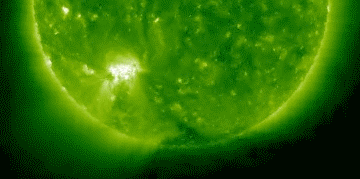
Additionally on Jan. 19th at 1340 UT, STEREO-B recorded the strongest solar flare in almost two years. Click the image to see the action on an ultraviolet movie of the blast. The M2-class eruption came from sunspot 1039, so that sunspot is likely still very active.
Spaceweather.com said that considering the sunspot was not even visible from Earth at the time of the eruption, the flare was probably much stronger than its M2 classification would suggest. This active region has produced at least three significant eruptions since Jan. 17th and it shows no signs of cooling off.
Sources: Eclipse 2010 blog, Spaceweather.com from 01/19/2010 , Kanabona.com
MESSENGER Solves Solar Flare Mystery
[/caption]
In a case of being in the right place at the right time, the MESSENGER spacecraft was able to capture a average-sized solar flare, allowing astronomers to study high-energy solar neutrons at less than 1 astronomical unit (AU) from the sun for the first time. When the flare erupted on Dec. 31, 2007, MESSENGER – on course for entering orbit around Mercury — was flying at about half an AU, said William C. Feldman, a scientist at the Planetary Science Institute. Previously, only the neutron bursts from the most powerful solar flares have been recorded on neutron spectrometers on Earth or in near-Earth orbit. The MESSENGER results help solve a mystery of why some coronal mass ejections produce almost no energetic protons that reach the Earth, while others produce huge amounts.
Solar flares spew high-energy neutrons into interplanetary space. Typically, these bursts last about 50 to 60 seconds at the sun. But MESSENGER’s Neutron Spectrometer was able to record neutrons from this flare over a period of six to ten hours. “What that’s telling us is that at least some moderate-sized flares continuously produce high-energy neutrons in the solar corona.” Said Feldman. “From this fact, we inferred the continuous production of protons in the 30-to-100-MeV (million electron volt) range due to the flare.”
About 90 percent of all ions produced by a solar flare remain locked to the sun on closed magnetic lines, but another population results from the decay of the neutrons near the sun. This second population of decayed neutrons forms an extended seed population in interplanetary space that can be further accelerated by the massive shock waves produced by the flares, Feldman said.
“So the important results are that perhaps after many flare events two things may occur: continuous production of neutrons over an extended period of time and creation of seed populations of neutrons near the sun that have decayed into protons,” Feldman said. “When coronal mass ejections (nuclear explosions in the corona) send shock waves into space, these feedstock protons are accelerated into interplanetary space.”
“There has always been the question of why some coronal mass ejections produce almost no energetic protons that reach the Earth, while others produce huge amounts,” he added. “It appears that these seed populations of energetic protons near the sun could provide the answer, because it’s easier to accelerate a proton that already has an energy of 1 MeV than a proton that is at 1 keV (the solar wind).”
The seed populations are not evenly distributed, Feldman said. Sometimes they’re in the right place for the shock waves to send them toward Earth, while at other times they’re in locations where the protons are accelerated in directions that don’t take them near Earth.
The radiation produced by solar flares is of more than academic interest to NASA, Feldman added. Energetic protons from solar flares can damage Earth-orbiting satellites and endanger astronauts on the International Space Station or on missions to the Moon and Mars.
“People in the manned spaceflight program are very interested in being able to predict when a coronal mass ejection is going to be effective in generating dangerous levels of high-energy protons that produce a radiation hazard for astronauts,” he said.
To do this, scientists need to know a lot more about the mechanisms that produce flares and which flare events are likely to be dangerous. At some point they hope to be able to predict space weather — where precipitation is in the form of radiation — with the same accuracy that forecasters predict rain or snow on Earth.
MESSENGER could provide significant data toward this goal, Feldman observed. “What we saw and published is what we hope will be the first of many flares we’ll be able to follow through 2012,” he said. “The beauty of MESSENGER is that it’s going to be active from the minimum to the maximum solar activity during Solar Cycle 24, allowing us to observe the rise of a solar cycle much closer to the sun than ever before.”
MESSENGER is currently orbiting the sun between 0.3 and 0.6 AU — (an AU is the average distance between the Earth and the sun, or about 150,000 km) — on its way to orbit insertion around Mercury in March 2011. At Mercury, it will be within 0.45 AU of the sun for one Earth year.
Read the team’s paper: Evidence for Extended Acceleration of Solar Flare Ions from 1-8-MeV Solar Neutrons Detected with the MESSENGER Neutron Spectrometer.
Source: PSI

